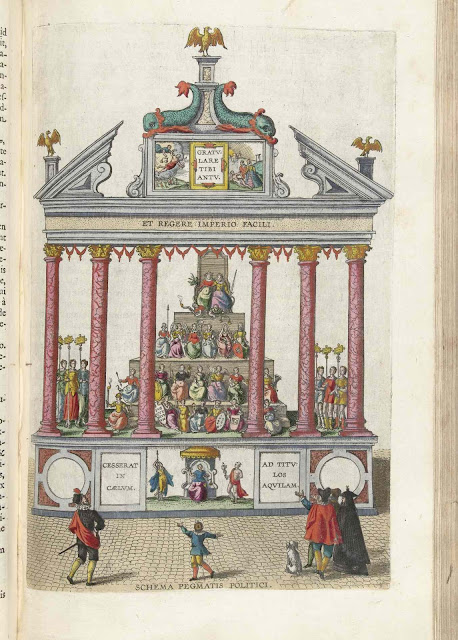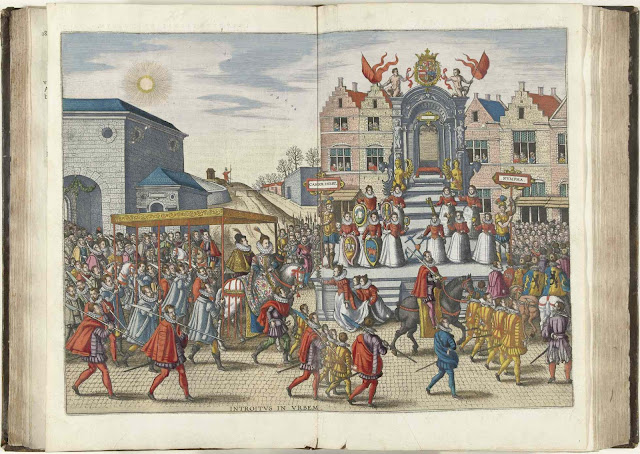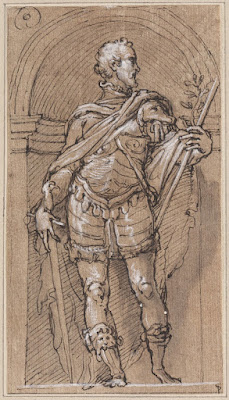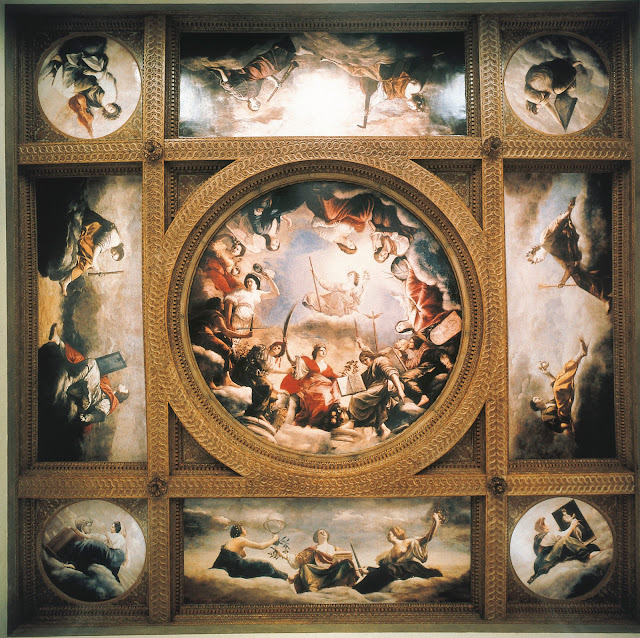These illustration-spreads with hand-colored etchings are from a memorial volume published in Antwerp in 1599 – Historica narratio profectionis et inaugurationis serenessimorum Belgii principum Alberti et Isabellae Austriae archiducum. Its purpose was to document and publicize the royal entry of the new Spanish Regents for the Low Countries, Archduke Albert of Austria and his wife, the Spanish Infanta Isabella Clara Eugenia.
Pieter van der Borch (ca. 1540-1608) was a long-established house artist for the Plantin Press in Antwerp. He produced these well-organized scenes as summaries of the rituals that actually took place. With equal care he recorded the fabulous temporary architecture created for the festivities – the triumphal arches dripping with ornament and shooting off flames, the decorative but functional stages erected for tableaux-vivants.
 |
| Pieter van der Borcht for Jan Moretus at the Plantin Press Archduke Albert and Isabella Clara Eugenia taking oaths 1599 hand-colored etching Rijksmuseum, Amsterdam |
 |
| Pieter van der Borcht for Jan Moretus at the Plantin Press Scene of Investiture in Grote Markt, Antwerp 1599 hand-colored etching Rijksmuseum, Amsterdam |
 |
| Pieter van der Borcht for Jan Moretus at the Plantin Press The Milanese Triumphal Arch in Antwerp 1599 hand-colored etching Rijksmuseum, Amsterdam |
 |
| Pieter van der Borcht for Jan Moretus at the Plantin Press The Spanish Triumphal Arch in Antwerp 1599 hand-colored etching Rijksmuseum, Amsterdam |
 |
| Pieter van der Borcht for Jan Moretus at the Plantin Press The Spanish Triumphal Arch in Antwerp (rear view) 1599 hand-colored etching Rijksmuseum, Amsterdam |
 |
| Pieter van der Borcht for Jan Moretus at the Plantin Press The Genoese Triumphal Arch in Antwerp 1599 hand-colored etching Rijksmuseum, Amsterdam |
 |
| Pieter van der Borcht for Jan Moretus at the Plantin Press The Genoese Triumphal Arch in Antwerp (rear view) 1599 hand-colored etching Rijksmuseum, Amsterdam |
 |
| Pieter van der Borcht for Jan Moretus at the Plantin Press The Portuguese Triumphal Arch in Antwerp 1599 hand-colored etching Rijksmuseum, Amsterdam |
 |
| Pieter van der Borcht for Jan Moretus at the Plantin Press Stage with tableau-vivant - Glorification of Agriculture 1599 hand-colored etching Rijksmuseum, Amsterdam |
 |
| Pieter van der Borcht for Jan Moretus at the Plantin Press Revolving theater with tableaux-vivants - War and Peace 1599 hand-colored etching Rijksmuseum, Amsterdam |
 |
| Pieter van der Borcht for Jan Moretus at the Plantin Press Triumphal Arch in honor of Women 1599 hand-colored etching Rijksmuseum, Amsterdam |
 |
| Pieter van der Borcht for Jan Moretus at the Plantin Press Stage with tableau-vivant - Crowning of Venus 1599 hand-colored etching Rijksmuseum, Amsterdam |
 |
| Pieter van der Borcht for Jan Moretus at the Plantin Press Stage with tableau-vivant - Glorification of Peace and Justice 1599 hand-colored etching Rijksmuseum, Amsterdam |










































